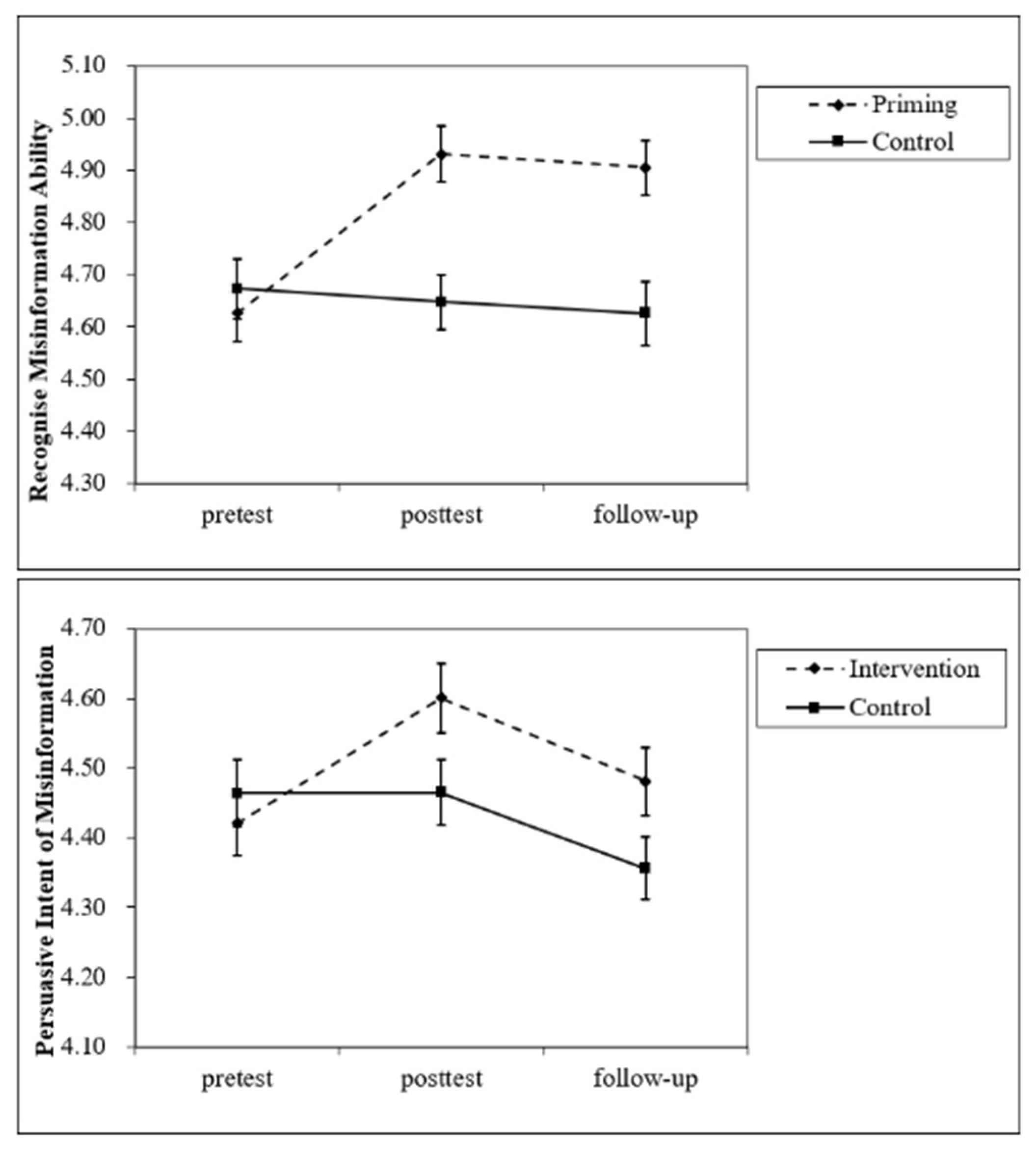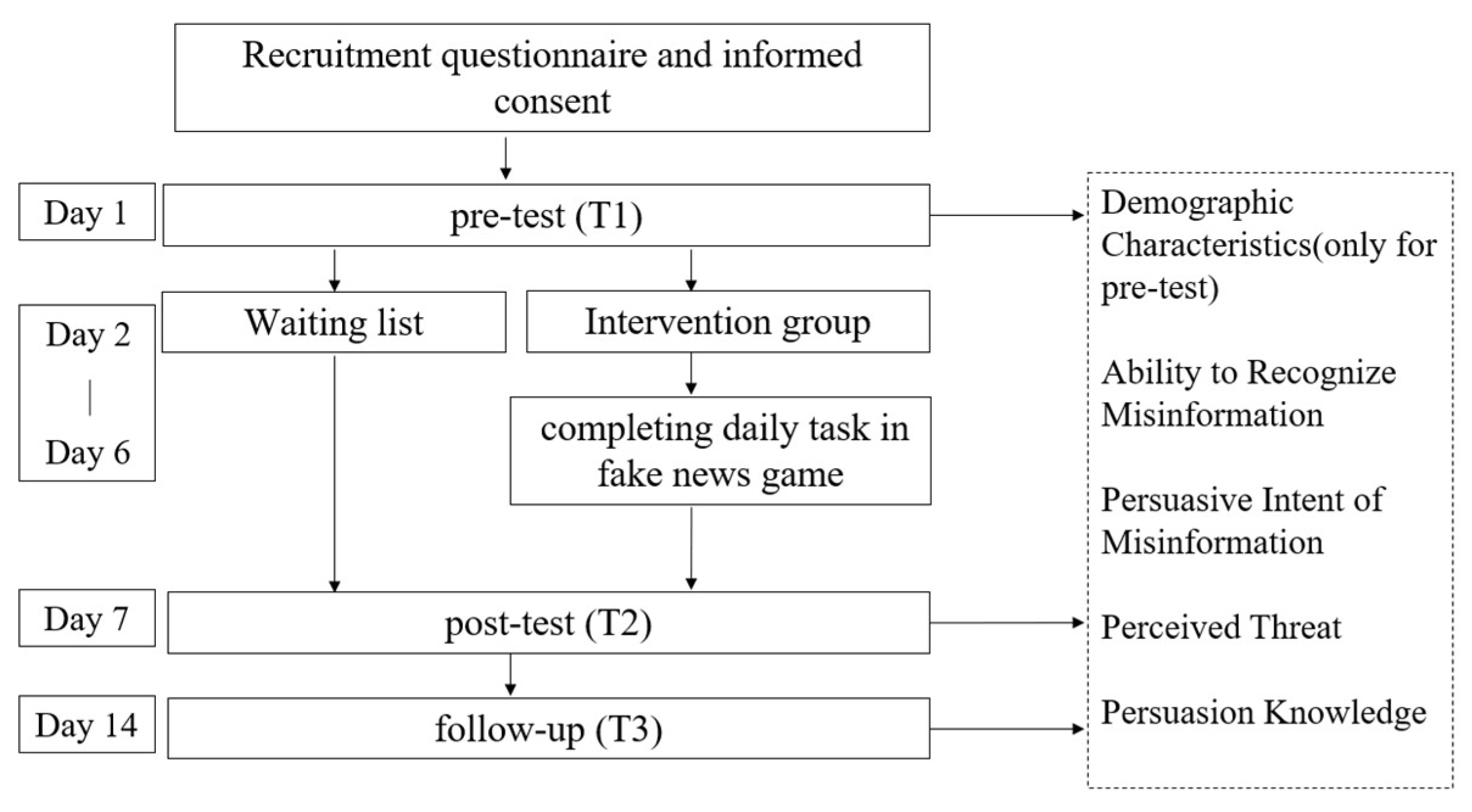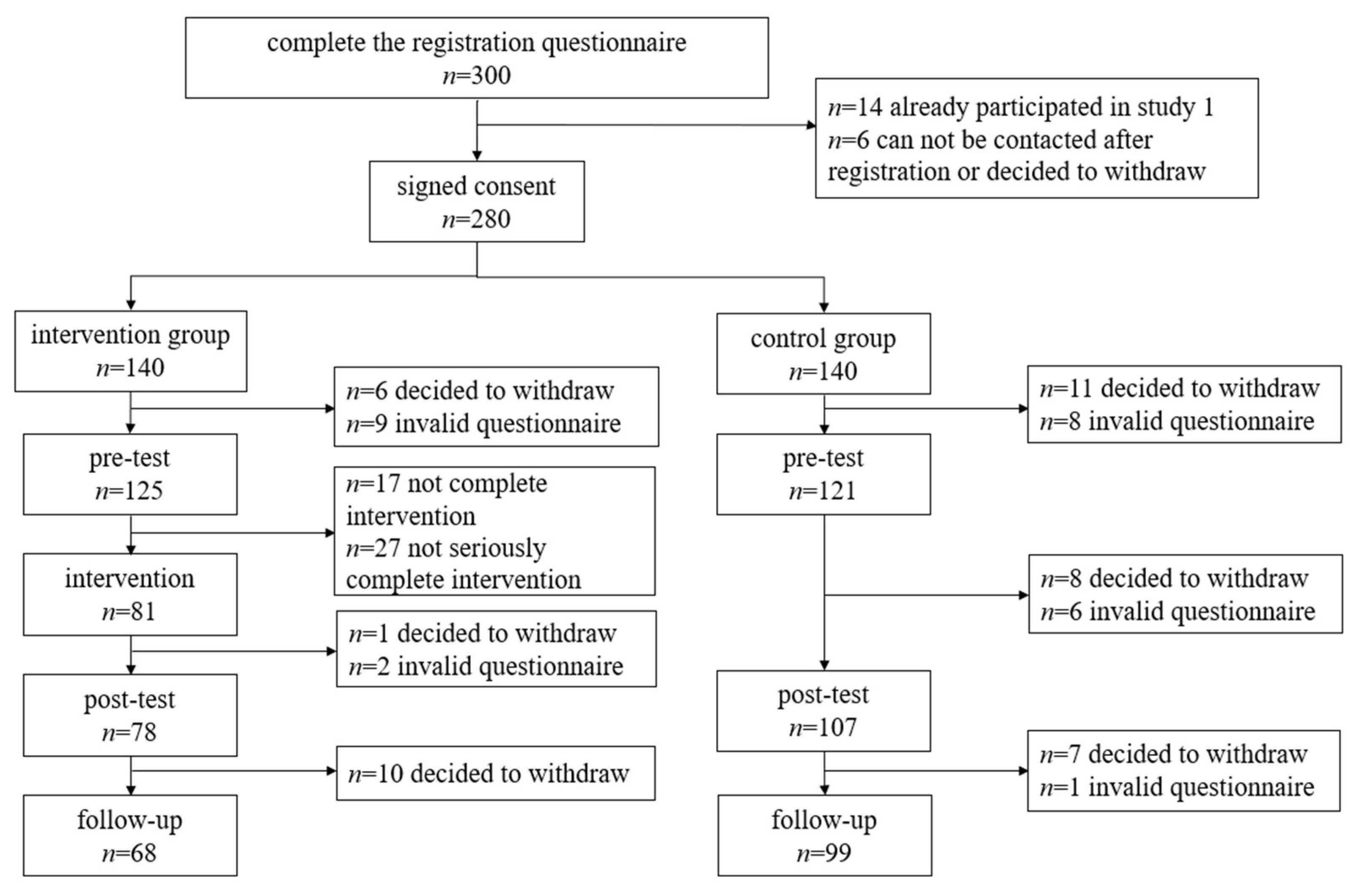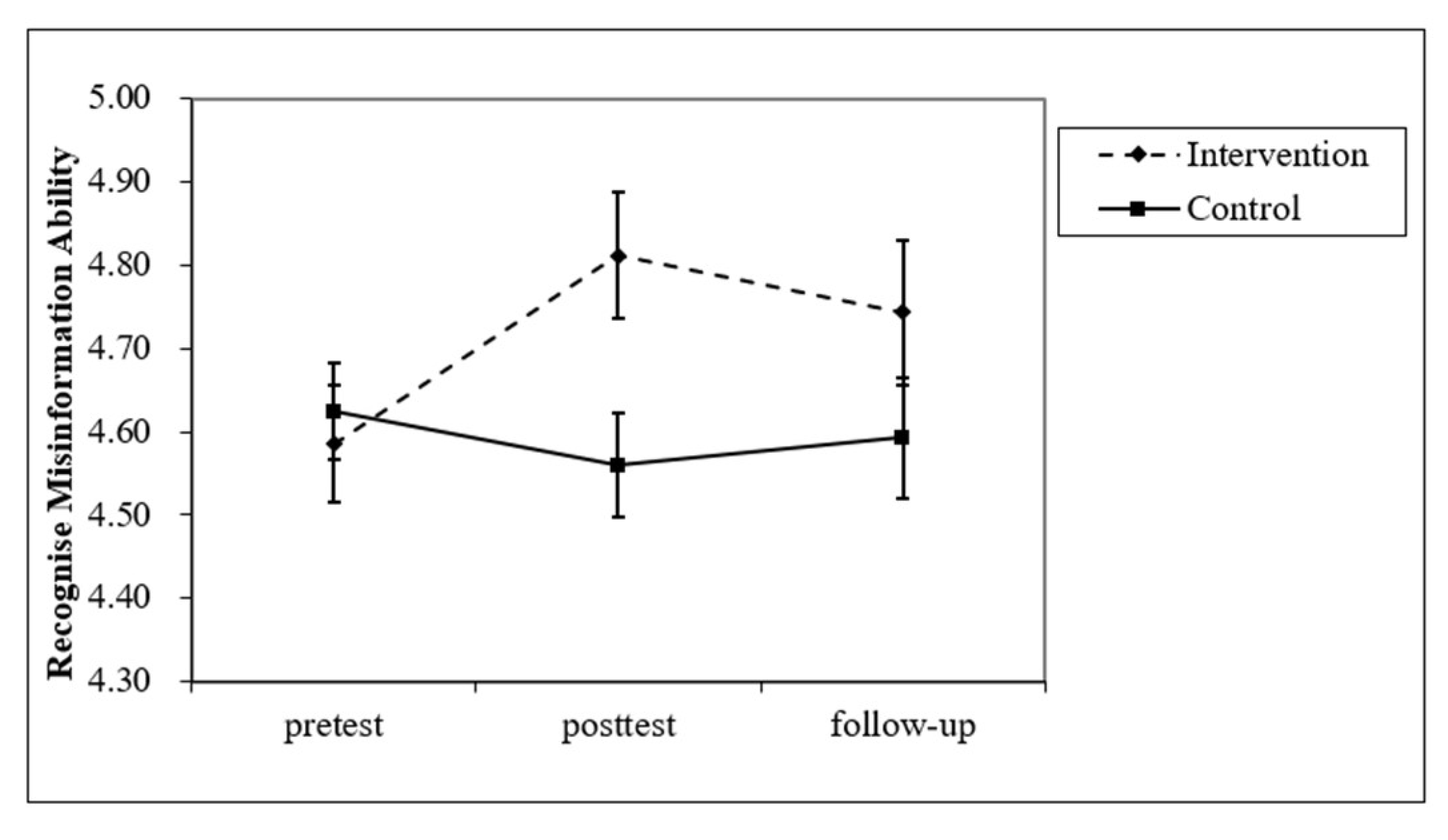Fighting COVID-19 Misinformation through an Online Game Based on the Inoculation Theory: Analyzing the Mediating Effects of Perceived Threat and Persuasion Knowledge
Abstract
1. Introduction
1.1. Inoculation Theory
1.2. Underlying Mechanisms of the Effect of Inoculation Interventions
1.3. Present Research
2. Study 1: Influence of Inoculation on Misinformation Discrimination: An Online Priming Study
2.1. Methods
2.1.1. Participants
2.1.2. Materials
- Demographic Characteristics
- Ability to Recognize Misinformation
- Persuasive Intent of Misinformation
2.1.3. Priming
“Wrong. This statement conveys misinformation. It strategically spreads false knowledge of the characteristics of the virus. The National Health Council notes that there is no evidence of mother-to-child transmission of the new coronavirus. If necessary, you can discuss with your obstetrician about whether to get pregnant.”
2.1.4. Procedure
2.1.5. Statistical Analysis
2.2. Results
2.2.1. Baseline Analysis
2.2.2. Effect of Inoculation Priming on Misinformation Discrimination
2.3. Discussion
3. Study 2: Influence of an Online Inoculation Intervention on Misinformation Discrimination: A Randomized Controlled Trial
3.1. Methods
3.1.1. Participants
3.1.2. Procedure
3.1.3. Intervention Procedure
3.1.4. Materials
- Demographic Characteristics
- Ability to Recognize Misinformation
- Persuasive Intent of Misinformation
- Perceived Threat Toward COVID-19-Related News
- Persuasion Knowledge of Online Misinformation
3.1.5. Statistical Analysis
3.2. Results
3.2.1. Attrition Analysis
3.2.2. Baseline Analysis
3.2.3. Effect of the Inoculation Intervention on Misinformation Discrimination
3.2.4. Mediating Effects of Persuasion Knowledge and Perceived Threat
3.3. Discussion
4. General Discussion
4.1. Effectiveness of the Inoculation Intervention
4.2. Underlying Mechanisms of the Effect of the Inoculation Intervention
4.3. Implications
4.4. Limitations
5. Conclusions
Author Contributions
Funding
Institutional Review Board Statement
Informed Consent Statement
Data Availability Statement
Acknowledgments
Conflicts of Interest
References
- Stjernswärd, S.; Ivert, A.-K.; Glasdam, S. Perceptions and effects of COVID-19 related information in Denmark and Sweden: A web-based survey about COVID-19 and social media. J. Public Health 2021, 1–15. [Google Scholar] [CrossRef]
- Gabarron, E.; Oyeyemi, S.O.; Wynn, R. Covid-19-related misinformation on social media: A systematic review. Bull. World Health Organ. 2021, 99, 455–463. [Google Scholar] [CrossRef]
- Tan, A.S.L.; Lee, C.-J.; Chae, J. Exposure to Health (Mis)Information: Lagged Effects on Young Adults’ Health Behaviors and Potential Pathways: Health (Mis)Information Exposure. J. Commun. 2015, 65, 674–698. [Google Scholar] [CrossRef]
- Brennen, J.S.; Simon, F.; Howard, P.N.; Nielsen, R.K. Types, Sources, and Claims of COVID-19 Misinformation; Reuters Institute for the Study of Journalism: Oxford, UK, 2020; Volume 7, pp. 1–13. [Google Scholar]
- Lee, J.J.; Kang, K.-A.; Wang, M.P.; Zhao, S.Z.; Wong, J.Y.H.; O’Connor, S.; Yang, S.C.; Shin, S. Associations between COVID-19 misinformation exposure and belief with COVID-19 knowledge and preventive behaviors: Cross-sectional online study. J. Med. Internet Res. 2020, 22, e22205. [Google Scholar] [CrossRef]
- Ferreira Caceres, M.M.; Sosa, J.P.; Lawrence, J.A.; Sestacovschi, C.; Tidd-Johnson, A.; Rasool, M.H.U.; Gadamidi, V.K.; Ozair, S.; Pandav, K.; Cuevas-Lou, C.; et al. The impact of misinformation on the COVID-19 pandemic. AIMS Public Health 2022, 9, 262–277. [Google Scholar] [CrossRef]
- WHO. Munich Security Conference. Director-General, Tedros Adhanom Ghebreyesus. Available online: https://www.who.int/zh/director-general/speeches/detail/munich-security-conference (accessed on 25 October 2022).
- Lewandowsky, S.; Ecker, U.K.H.; Seifert, C.M.; Schwarz, N.; Cook, J. Misinformation and Its Correction: Continued Influence and Successful Debiasing. Psychol. Sci. Public Interest 2012, 13, 106–131. [Google Scholar] [CrossRef]
- Pennycook, G.; Cannon, T.D.; Rand, D.G. Prior exposure increases perceived accuracy of fake news. J. Exp. Psychol.-Gen. 2018, 147, 1865–1880. [Google Scholar] [CrossRef]
- Kucharski, A. Post-truth: Study epidemiology of fake news. Nature 2016, 540, 525. [Google Scholar] [CrossRef]
- McGuire, W.J. Resistance to persuasion conferred by active and passive prior refutation of the same and alternative counterarguments. J. Abnorm. Soc. Psychol. 1961, 63, 326–332. [Google Scholar] [CrossRef]
- Compton, J. Inoculation theory. In The SAGE Handbook of Persuasion: Developments in Theory and Practice; Dillard, J.P., Shen, L., Eds.; SAGE: Thousand Oaks, CA, USA, 2013; Volume 2, pp. 220–237. [Google Scholar]
- van der Linden, S.; Leiserowitz, A.; Rosenthal, S.; Maibach, E. Inoculating the Public against Misinformation about Climate Change. Glob. Chall. 2017, 1, 1600008. [Google Scholar] [CrossRef]
- Bonetto, E.; Troïan, J.; Varet, F.; Lo Monaco, G.; Girandola, F. Priming Resistance to Persuasion decreases adherence to Conspiracy Theories. Soc. Influ. 2018, 13, 125–136. [Google Scholar] [CrossRef]
- Roozenbeek, J.; van der Linden, S. The fake news game: Actively inoculating against the risk of misinformation. J. Risk Res. 2019, 22, 570–580. [Google Scholar] [CrossRef]
- Roozenbeek, J.; van der Linden, S. Fake news game confers psychological resistance against online misinformation. Palgrave Commun. 2019, 5, 65. [Google Scholar] [CrossRef]
- Compton, J.A.; Pfau, M. Inoculation Theory of Resistance to Influence at Maturity: Recent Progress In Theory Development and Application and Suggestions for Future Research. Ann. Int. Commun. Assoc. 2005, 29, 97–146. [Google Scholar] [CrossRef]
- Compton, J.; Jackson, B.; Dimmock, J.A. Persuading others to avoid persuasion: Inoculation theory and resistant health attitudes. Front. Psychol. 2016, 7, 122. [Google Scholar] [CrossRef]
- Compton, J.; Ivanov, B. Untangling Threat during Inoculation-Conferred Resistance to Influence. Commun. Rep. 2012, 25, 1–13. [Google Scholar] [CrossRef]
- Friestad, M.; Wright, P. The Persuasion Knowledge Model: How People Cope with Persuasion Attempts. J. Consum. Res. 1994, 21, 1–31. [Google Scholar] [CrossRef]
- Cameron, K.A. A practitioner’s guide to persuasion: An overview of 15 selected persuasion theories, models and frameworks. Patient Educ. Couns. 2008, 74, 309–317. [Google Scholar] [CrossRef]
- Amazeen, M.A.; Bucy, E.P. Conferring Resistance to Digital Disinformation: The Inoculating Influence of Procedural News Knowledge. J. Broadcast. Electron. Media 2019, 63, 415–432. [Google Scholar] [CrossRef]
- Jacobs, R. Playing to Win Over: Validating Persuasive Games; Erasmus University Rotterdam: Rotterdam, The Netherlands, 2017. [Google Scholar]
- Wojdynski, B.W.; Evans, N.J. Going Native: Effects of Disclosure Position and Language on the Recognition and Evaluation of Online Native Advertising. J. Advert. 2015, 45, 157–168. [Google Scholar] [CrossRef]
- NHC. Notification on the Quality Control of Nucleic Acid Testing of New Coronavirus under the Normal Prevention and Control of the Pandemic. Available online: http://www.nhc.gov.cn/xcs/fkdt/202006/fbe040587e1940eba50204f6a9751c7c.shtml (accessed on 2 June 2020).
- Goodman, E.; Adler, N.E.; Kawachi, I.; Frazier, A.L.; Huang, B.; Colditz, G.A. Adolescents’ perceptions of social status: Development and evaluation of a new indicator. Pediatrics 2001, 108, e31. [Google Scholar] [CrossRef]
- Pennycook, G.; McPhetres, J.; Zhang, Y.; Rand, D. Fighting COVID-19 misinformation on social media: Experimental evidence for a scalable accuracy nudge intervention. Psychol. Sci. 2020, 31, 770–780. [Google Scholar] [CrossRef]
- Carlson, J.P.; Bearden, W.O.; Hardesty, D.M. Influences on what consumers know and what they think they know regarding marketer pricing tactics. Psychol. Mark. 2007, 24, 117–142. [Google Scholar] [CrossRef]
- Basol, M.; Roozenbeek, J.; van der Linden, S. Good News about Bad News: Gamified Inoculation Boosts Confidence and Cognitive Immunity Against Fake News. J. Cogn. 2020, 3, 2. [Google Scholar] [CrossRef]
- Compton, J.; Linden, S.; Cook, J.; Basol, M. Inoculation theory in the post-truth era: Extant findings and new frontiers for contested science, misinformation, and conspiracy theories. Soc. Personal. Psychol. Compass 2021, 15, e12602. [Google Scholar] [CrossRef]
- Hupbach, A.; Gomez, R.; Nadel, L. Episodic memory reconsolidation: Updating or source confusion? Memory 2009, 17, 502–510. [Google Scholar] [CrossRef]
- Martin, B.; McNally, J.; Taggar, S. Determining the Importance of Self-Evaluation on the Goal-Performance Effect in Goal Setting: Primary Findings. Can. J. Behav. Sci. Rev. Can. Sci. Comport. 2016, 48, 91–100. [Google Scholar] [CrossRef]
- Mahmood, K.; University of the, P. Do People Overestimate Their Information Literacy Skills? A Systematic Review of Empirical Evidence on the Dunning-Kruger Effect. Commun. Inf. Lit. 2016, 10, 199–213. [Google Scholar] [CrossRef]
- Banas, J.A.; Richards, A.S. Apprehension or motivation to defend attitudes? Exploring the underlying threat mechanism in inoculation-induced resistance to persuasion. Commun. Monogr. 2017, 84, 164–178. [Google Scholar] [CrossRef]
- O’Keefe, D.J. Message Properties, Mediating States, and Manipulation Checks: Claims, Evidence, and Data Analysis in Experimental Persuasive Message Effects Research. Commun. Theory 2003, 13, 251–274. [Google Scholar] [CrossRef]
- Banas, J.A.; Rains, S.A. A meta-analysis of research on inoculation theory. Commun. Monogr. 2010, 77, 281–311. [Google Scholar] [CrossRef]
- Barnett, G.; Boster, F.J. Progress in Communication Sciences: Advances in Persuasion; Greenwood Publishing Group: Santa Barbara, CA, USA, 1997. [Google Scholar]
- Rosenstiel, R.; Elizabeth, J. Journalists can Change the Way They Build Stories to Create Organic News Fluency. Available online: https://www.americanpressinstitute.org/publications/reports/white-papers/organic-news-fluency (accessed on 29 October 2022).
- Peng, W.; Lim, S.; Meng, J. Persuasive strategies in online health misinformation: A systematic review. Inf. Commun. Soc. 2022, 1–18. [Google Scholar] [CrossRef]
- Roozenbeek, J.; Schneider, C.R.; Dryhurst, S.; Kerr, J.; Freeman, A.L.J.; Recchia, G.; van der Bles, A.M.; van der Linden, S. Susceptibility to misinformation about COVID-19 around the world. R. Soc. Open Sci. 2020, 7, 201199. [Google Scholar] [CrossRef]
- Phadke, V.K.; Bednarczyk, R.A.; Salmon, D.A.; Omer, S.B. Association Between Vaccine Refusal and Vaccine-Preventable Diseases in the United States: A Review of Measles and Pertussis. JAMA J. Am. Med. Assoc. 2016, 315, 1149–1158. [Google Scholar] [CrossRef] [PubMed]
- Kata, A. A postmodern Pandora’s box: Anti-vaccination misinformation on the Internet. Vaccine 2009, 28, 1709–1716. [Google Scholar] [CrossRef] [PubMed]
- Islam, M.S.; Kamal, A.-H.M.; Kabir, A.; Southern, D.L.; Khan, S.H.; Hasan, S.M.M.; Sarkar, T.; Sharmin, S.; Das, S.; Roy, T.; et al. COVID-19 vaccine rumors and conspiracy theories: The need for cognitive inoculation against misinformation to improve vaccine adherence. PLoS ONE 2021, 16, e0251605. [Google Scholar] [CrossRef] [PubMed]
- Andersson, G.; Topooco, N.; Havik, O.; Nordgreen, T. 6 Internet-supported versus face-to-face cognitive behavior therapy for depression. Expert Rev. Neurother. 2016, 16, 55–60. [Google Scholar] [CrossRef]
- Racey, M.; O’Brien, C.; Douglas, S.; Marquez, O.; Hendrie, G.; Newton, G. Systematic Review of School-Based Interventions to Modify Dietary Behavior: Does Intervention Intensity Impact Effectiveness? J. Sch. Health 2016, 86, 452–463. [Google Scholar] [CrossRef] [PubMed]
- Maertens, R.; Roozenbeek, J.; Basol, M.; van der Linden, S. Long-term effectiveness of inoculation against misinformation: Three longitudinal experiments. J. Exp. Psychol. Appl. 2021, 27, 1–16. [Google Scholar] [CrossRef]
- Guess, A.; Nagler, J.; Tucker, J. Less than you think: Prevalence and predictors of fake news dissemination on Facebook. Asian Australas. J. Anim. Sci. 2019, 32, eaau4586. [Google Scholar] [CrossRef]
- Yin, C.; Zhang, X.; Liu, L. Reposting negative information on microblogs: Do personality traits matter? Inf. Process. Manag. 2020, 57, 102106. [Google Scholar] [CrossRef]
- Van Damme, W.; Dahake, R.; Delamou, A.; Ingelbeen, B.; Wouters, E.; Vanham, G.; Van De Pas, R.; Dossou, J.-P.; Ir, P.; Abimbola, S. The COVID-19 pandemic: Diverse contexts; different epidemics—How and why? BMJ Glob. Health 2020, 5, e003098. [Google Scholar] [CrossRef] [PubMed]
- Tsfati, Y.; Boomgaarden, H.G.; Strömbäck, J.; Vliegenthart, R.; Damstra, A.; Lindgren, E. Causes and consequences of mainstream media dissemination of fake news: Literature review and synthesis. Ann. Int. Commun. Assoc. 2020, 44, 157–173. [Google Scholar] [CrossRef]
- Humprecht, E. Where ’fake news’ flourishes: A comparison across four Western democracies. Inf. Commun. Soc. 2019, 22, 1973–1988. [Google Scholar] [CrossRef]





| Control Group | Priming Group | |||
|---|---|---|---|---|
| M | SD | M | SD | |
| ARM T1 | 4.670 | 0.629 | 4.629 | 0.626 |
| ARM T2 | 4.640 | 0.570 | 4.937 | 0.625 |
| ARM T3 | 4.627 | 0.672 | 4.904 | 0.602 |
| PIM T1 | 4.461 | 0.534 | 4.423 | 0.544 |
| PIM T2 | 4.458 | 0.515 | 4.607 | 0.577 |
| PIM T3 | 4.348 | 0.498 | 4.488 | 0.564 |
| Control Group | Intervention Group | |||
|---|---|---|---|---|
| M | SD | M | SD | |
| ARM T1 | 4.606 | 0.623 | 4.610 | 0.560 |
| ARM T2 | 4.549 | 0.541 | 4.829 | 0.713 |
| ARM T3 | 4.577 | 0.692 | 4.766 | 0.783 |
| PIM T1 | 4.501 | 0.640 | 4.563 | 0.570 |
| PIM T2 | 4.441 | 0.536 | 4.752 | 0.709 |
| PIM T3 | 4.373 | 0.579 | 4.616 | 0.705 |
Disclaimer/Publisher’s Note: The statements, opinions and data contained in all publications are solely those of the individual author(s) and contributor(s) and not of MDPI and/or the editor(s). MDPI and/or the editor(s) disclaim responsibility for any injury to people or property resulting from any ideas, methods, instructions or products referred to in the content. |
© 2023 by the authors. Licensee MDPI, Basel, Switzerland. This article is an open access article distributed under the terms and conditions of the Creative Commons Attribution (CC BY) license (https://creativecommons.org/licenses/by/4.0/).
Share and Cite
Ma, J.; Chen, Y.; Zhu, H.; Gan, Y. Fighting COVID-19 Misinformation through an Online Game Based on the Inoculation Theory: Analyzing the Mediating Effects of Perceived Threat and Persuasion Knowledge. Int. J. Environ. Res. Public Health 2023, 20, 980. https://doi.org/10.3390/ijerph20020980
Ma J, Chen Y, Zhu H, Gan Y. Fighting COVID-19 Misinformation through an Online Game Based on the Inoculation Theory: Analyzing the Mediating Effects of Perceived Threat and Persuasion Knowledge. International Journal of Environmental Research and Public Health. 2023; 20(2):980. https://doi.org/10.3390/ijerph20020980
Chicago/Turabian StyleMa, Jinjin, Yidi Chen, Huanya Zhu, and Yiqun Gan. 2023. "Fighting COVID-19 Misinformation through an Online Game Based on the Inoculation Theory: Analyzing the Mediating Effects of Perceived Threat and Persuasion Knowledge" International Journal of Environmental Research and Public Health 20, no. 2: 980. https://doi.org/10.3390/ijerph20020980
APA StyleMa, J., Chen, Y., Zhu, H., & Gan, Y. (2023). Fighting COVID-19 Misinformation through an Online Game Based on the Inoculation Theory: Analyzing the Mediating Effects of Perceived Threat and Persuasion Knowledge. International Journal of Environmental Research and Public Health, 20(2), 980. https://doi.org/10.3390/ijerph20020980







